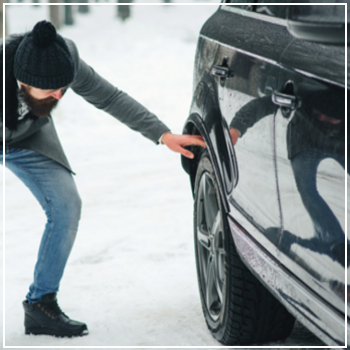When the weather forecast calls for snow and ice, you'll often see town trucks spreading rock salt across Connecticut's roads. This method has been around since the 1930s and helps reduce ice formation, making roads safer for drivers. However, as vehicles pass over these salt-covered surfaces, tiny salt particles can be thrown up into vulnerable spots like the undercarriage, wheel wells, doors, and fenders. If not cleaned promptly, this can lead to rapid corrosion. Unfortunately, the combination of salt, dirt, and moisture creates a perfect storm for your vehicle's metal components. Over time, this can lead to rust forming on exposed surfaces, which might eventually compromise the structural integrity of your car if left unchecked. It's essential to take proactive steps to safeguard your vehicle from these damaging elements. Rust occurs when exposed metal reacts with water, a process accelerated by the presence of salt. This means that even minor scratches or imperfections in your car's finish can quickly lead to rust formation. To protect your car, it's crucial to adopt a dual strategy: first, prevent damage to the paint and finish by avoiding scratches, dings, and dents; second, regularly clean your vehicle to remove any accumulated salt before it has a chance to cause harm. One effective way to shield your car from the corrosive effects of road salt is by applying a fresh coat of wax. This forms a protective layer that not only guards against rocks and debris but also helps moisture bead up and roll off the surface. Make sure to apply wax to both the exterior body and the undercarriage, paying special attention to areas prone to salt buildup. Regular touch-ups are recommended to maintain optimal protection. Even after waxing, always inspect your car for scratches after driving on salted roads. Repair any visible damage immediately by repainting the affected area and reapplying wax to seal it. In harsh winter conditions, simply waxing your vehicle might not be enough. Consider having your car professionally rustproofed. This involves applying a specialized oil over the entire surface, including hard-to-reach areas such as door seams and undercarriage crevices. These areas are particularly susceptible to rust, which can spread unnoticed until it becomes severe. For parts of your vehicle that are frequently exposed to moisture, a thicker coating of rustproofing oil is applied to provide enhanced resistance. This extra layer of protection can significantly extend the life of your vehicle and save you money in the long run. After driving on salted roads, it's important to thoroughly wash your car to remove any accumulated debris, dirt, and salt. You can do this at home using a garden hose or opt for a professional car wash that uses high-pressure hoses to target hard-to-reach areas like the undercarriage, fender, and wheel wells. Here are some tips for effective cleaning: If you must venture out during snowy or icy conditions, try to avoid areas known for heavy salt deposition. Some places to steer clear of include: It's easy to overlook the interior when thinking about protecting your car from salt. However, walking through snow to reach your vehicle often results in salt and dirt being tracked inside, where it can stain carpets and mats and potentially seep into the metal components beneath. To prevent this, regularly clean your car's interior, including vacuuming and washing the carpets. Placing rubber mats on high-traffic areas can help catch residue and keep your car looking its best. For comprehensive protection during the winter months, consider having DaSilva’s Auto Body perform a rustproofing treatment or apply a thorough wax job. Contact their Naugatuck shop today to schedule an appointment and ensure your vehicle stays protected throughout the season. A buffer is a part of the buffers-and-chain coupling system used on the railway systems of many countries, among them most of those in Europe, for attaching railway vehicles to one another. Rail Buffer,Train Buffer Stop,Sliding Type Rail Buffer,Hydraulic Sliding Type Rail Buffer Shenyang Lubang Railway Maintenance Machinery Co.,Ltd. , https://www.srmfrailwayequip.com
The Impact of Road Salt
Protective Measures: Wax Application
Rustproofing for Extra Protection
Regular Washing Is Key
Choose Your Driving Routes Wisely
Don't Neglect the Interior
Fitted at the ends of the vehicle frames, one at each corner, the buffers are projecting, shock-absorbing pads which, when vehicles are coupled, are brought into contact with those on the next vehicle. The draw chain used between each pair of vehicles includes a screw which is tightened after coupling to shorten the chain and keep the buffers pressed together. Such is known as a 'screw coupling'.